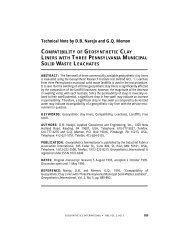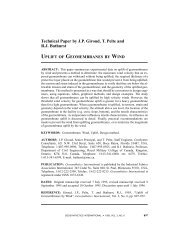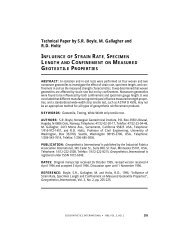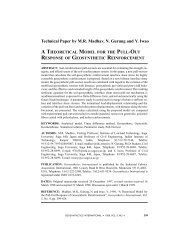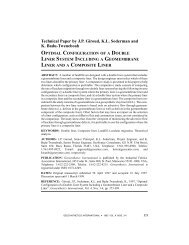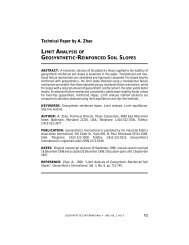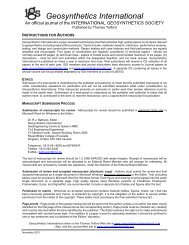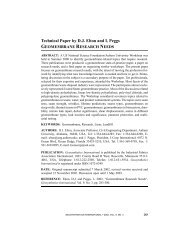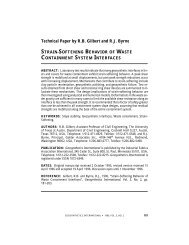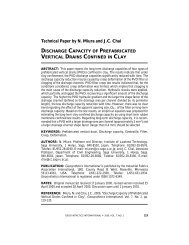Technical Paper by J.H. Greenwood - IGS - International ...
Technical Paper by J.H. Greenwood - IGS - International ...
Technical Paper by J.H. Greenwood - IGS - International ...
Create successful ePaper yourself
Turn your PDF publications into a flip-book with our unique Google optimized e-Paper software.
DISCUSSION AND CLOSURE D Designing to Residual Strength Instead of Stress-Rupture<br />
lower factor is appropriate if the critical state friction angle, orfactored strength parameters,<br />
are used in the design. Thus the conversion from T * ,orT O ,toT S is code dependent.<br />
The term “overloading” in the context of reinforcement rupture of a reinforced soil<br />
structure really means overloading of the reinforcement elements. As such, an extreme<br />
(hence short lived) increase in surcharge on the wall may only be a minor contributor<br />
to “overloading”. In geotechnical engineering, “overloading” can be long term or short<br />
lived. Long term “overloading” can be caused <strong>by</strong> soil strength parameters lower than<br />
those assumed in the design and is conceivable if the design is based on unfactored<br />
peak strength parameters. The residual strength method appears to be for short-lived<br />
“overloading”. It is likely that the most severe “overloading” considered in a design<br />
(as specified <strong>by</strong> a load combination and partial load factors) is short-lived, and the residual<br />
strength method is most appropriate. However, a less severe “overloading” of a<br />
long term nature is still possible. This condition needs to be defined, say, <strong>by</strong> another<br />
load combination with less severe partial load factors, and be checked using the stress<br />
rupture method.<br />
A related point that needs clarification is how the residual strength needs to be determined.<br />
Figure 2 of the author’s paper and the empirical Equation 4 for polyester appear<br />
to suggest a quick tensile test. In reinforced soil structures, even short-lived “overloading”<br />
is rarely transient in nature but may have a duration of days or weeks. This is because<br />
short-lived “overloading” may be caused <strong>by</strong> an increase in pore water pressure<br />
(say, due to more severe flooding than that specified) or over-excavation, etc. Hence,<br />
the geotechnical community and code drafting bodies have to agree on a duration for<br />
short-lived “overloading”. Once such an agreement is reached, the residual strength<br />
curve can be determined <strong>by</strong> maintained load tests where the residual strengths are available<br />
for the specified duration.<br />
REFERENCE<br />
Enrich M. and Mitchell, J.K., 1994, “Working Stress Design for Reinforced Soil<br />
Walls”, Journal of Geotechnical Engineering, Vol. 120, No. 4, pp. 625-645.<br />
Closure <strong>by</strong> J.H. <strong>Greenwood</strong><br />
The intention of the author’s paper was to point out that static load can be treated as a<br />
factor that leads to a gradual reduction in strength in the same manner as ultraviolet light<br />
or a chemical agent. This will lead to partial safety factors that are more realistic than<br />
those obtained <strong>by</strong> considering the stress-rupture diagram. The discusser is right to point<br />
out that this must be integrated correctly into current codes for designing reinforced<br />
soil. The various load levels, T, should be defined with care and the reason for applying<br />
each individual partial safety factor should be examined.<br />
The following is a simple numerical example to illustrate further the relation between<br />
residual strength and stress-rupture. Suppose that the residual strength T R decreases linearly<br />
with time from an initial value of unity and in proportion to (using the discusser’s<br />
notation) the sustained load T S as follows:<br />
GEOSYNTHETICS INTERNATIONAL S 1997, VOL. 4, NO. 6<br />
675



